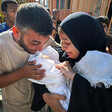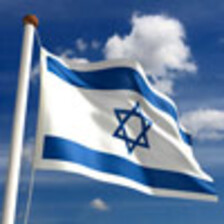The Electronic Intifada 26 March 2004

Production still from Peace, Propaganda, and the Promised Land
I’m sure newspaper editors everywhere fantasize the day when they don’t receive a single letter charging their publication with “bias.” This notion of bias is quite vague — it can mean that a publication presents a story as too sympathetic with one side of an issue (be it abortion, affirmative action, or the Israeli-Palestinian conflict) or that a news source doesn’t present one side of the story at all. And because the word bias is thrown around so often, like the word “terrorism,” the meaning of the term has been pretty much diluted due to over/misuse.
Thankfully, the new documentary Peace, Propaganda, and the Promised Land, from the Media Education Foundation, goes beyond charging the U.S. news media (particularly television news) of being biased in favor of the Israeli government. A series of filters is identified, describing how and why certain orthodoxies appear in the news media, and how these filters shape news coverage of the Israeli-Palestinian conflict.
Anyone who has read more than a handful of U.S. news reports on the Israeli-Palestinian conflict knows what these orthodoxies are. No historical context regarding the illegality of Israel’s colonizing settlements in the West Bank and Gaza Strip is provided. Israel retaliates, while Palestinians provoke. Yasser Arafat inexplicably turned down Ehud Barak’s unprecedented generous offer and incited the current intifada out of spite towards Israel. The United States is an impartial peace broker. Relative quiet exists when it’s only Palestinians who are dying. What is missing from the coverage is what it means for Palestinians to endure checkpoints and curfews, as well as Israeli voices of dissent, and the billions of dollars the U.S. gives to Israel each year. But why are these conventions so pervasive in the media?

Production still from Peace, Propaganda, and the Promised Land
What is surprising about this analysis is that organizations like AIPAC and CAMERA are considered secondary to the corporate interests of media corporations and the political elites who decide which reporters and publications have access to Washington. But to these filters I would add some more — especially that of the logistical problems facing reporters stationed in the Middle East. First of all, there is the problem of language (not enough reporters understand Arabic), and of course the checkpoints (good luck getting to Jenin to report on an alleged massacre if Israel won’t let you through). Then there is the minimal knowledge of Arab culture possessed by reporters dispatched to the region, and the historic Orientalist attitudes towards Arabs by Americans is not to be dismissed.
So what does it mean when historical truths like the illegality of the 36-year occupation of the West Bank, Gaza Strip, and East Jerusalem are not included in news reports of violence between Israeli soldiers and Palestinians? Neve Gordon, of Ta’ayush & Ben Gurion University, explains in the film, “When one lives under oppression and there is no other way out, and [one is] being violated every day, by violent means, sometimes the only way out of that situation is through violence.”
However, when context is omitted, newspaper readers and television viewers have a very skewed understanding of the conflict. Hanan Ashrawi, member of the Palestinian Legislative Council, adds, “The tanks, the gunships, the snipers, they are all on Palestinian land, and I don’t see why they have to protect themselves on our land if they’re occupying our land. That context is always missing. So when Israel is busy murdering people in cold blood, it is presented as part of the self-defense mechanism of Israel.”
Without historical context, it is as though the violence is being committed in a vacuum. Pundits attribute suicide bombers to Palestinian hatred, instead of understanding such violence as guerilla tactics borne as a result of growing frustration towards the roots of the conflict — the dispossession of the Palestinians, the daily humiliation by the Israeli occupiers, and the continued colonization of Palestinian land.
Robert Fisk, the Middle East correspondent for The Independent, says, “I was very close to the pizzeria [suicide] bombing in Jerusalem in August of last year [2002], and I got there faster than the police did. And I saw an Israeli baby without a head, a woman with a chair leg sticking out of her chest. I my reporting, for example, I’m pretty brutal about suicide bombers. I call them wicked … but I also make a point of saying, ‘Why?’”

Production still from Peace, Propaganda, and the Promised Land
This question, “Why?”, is not seriously posed often enough by American journalists. The answer to this question can be seen in the landscape of the conflict — the Jews-only settlements (which are sometimes merely referred to as Jewish neighborhoods by the press), curfews, checkpoints, dilapidated refugee camps — all obvious sources of Palestinian anger and strife. But this imagery doesn’t make it through the aforementioned filters.
These filters have also resulted in the omission of the Israeli peace movement from news coverage. Gila Svirsky, and Israeli peace campaigner, explains, “We in the women’s peace camp in Israel organized a mass vigil of women in black and a mass march through the streets of Jerusalem, 2,000 women strong, both Israelis and Palestinians. Can you picture that dramatic moment? 2,000 women dressed in black marching down the streets of Jerusalem, to the walls of the old city, where we hung banners … saying peace in three languages — Hebrew, Arabic, and English. And guess what — it didn’t get into the media.”
Neve Gordon explains that these images contradict the image that the media has been giving for years, and they are omitted because they contradict past reporting. And, of course, as the documentary reminds us, there is the perpetual threat of being labeled anti-Semitic for criticizing Israel, or being labeled a “self-hating Jew.” But one aspect the film doesn’t touch upon is that violence sells a newspaper or gets a viewer to watch — peace doesn’t sell. As the old news cliche goes, if it bleeds, it leads.
And as the film’s narrator explains, “Through its unconditional support of Israel, the American government has become one of the biggest obstacles to achieving peace. Consequently, the struggle for peace and justice in the Middle East will have to be waged here in the United States.” So it is quite dire that Americans develop a more sophisticated understanding of the Israeli-Palestinian conflict, which dominates both headlines and international politics.
“Americans need to wake up and find out what’s being done in their name throughout the world. They have a responsibility. If they live in a democratic society, which is being eroded in terms of how democratic it is, in terms of what [their] government’s supporting, what it’s doing overseas in [their names] and with [their] tax dollars,” Communications Director of the Institute for Public Accuracy Sam Husseini asserts in the section of the film entitled “Is peace possible?”
To Husseini I would add that the media has for far too long neglected their responsibility to not self-censor in order to alienate a special interest group or the political elite which controls media access, and to actually report what they see, and to not mince words in an attempt to satisfy a select few. As it is explained in the film, journalists have become part of the game of power, instead of monitoring it as they should.
Related Links
Maureen Clare Murphy is an Arts, Music, and Culture correspondent for EI and its sister site Electronic Iraq



